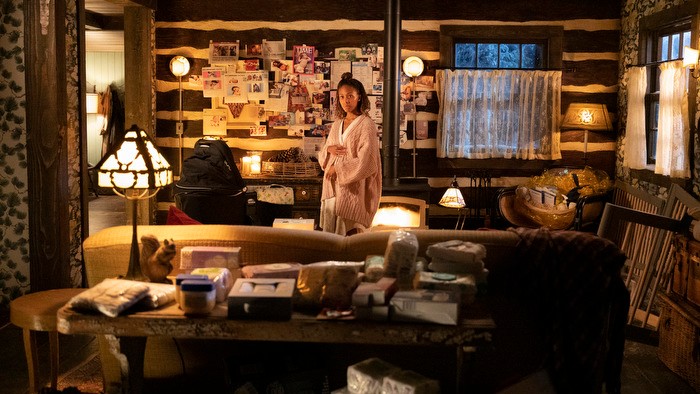
Solos is a new 7-episode series now on Amazon Prime Video from Writer/Producer David Weil (Hunters), and it’s unlike anything else you’re likely to see on cable, streaming or network television.
Each 25 to 30-minute episode features a different actor: Anne Hathaway, Helen Mirren, Anthony Mackie, Uzo Aduba, Constance Wu, Morgan Freeman, Dan Stevens and Nicole Beharie, each of them playing a different character. Most of these segments are essentially a one-person monologue where we learn more about each character as it goes along, but there are also elements of science fiction, some more overt than others. Although the actors’ performances and the stories will be a key motivation to watch Solos, you’re also likely to marvel at the fantastic environments and sets created for each character.
It’s the work of Production Designer Ruth Ammon, a three-time Emmy nominee for her work on NBC’s Heroes, as well as an Art Directors Guild Awards nominee for her work on the TNT show, The Alienist. In fact, Ammon has been working in television for nearly 30 years with a few forays into indie film as well, so she was up to the task of creating seven single-use environments for a show made in the middle of a pandemic.
Below the Line got on the phone with Ammon while she was busy working on her next show, Station Eleven for HBO Max.
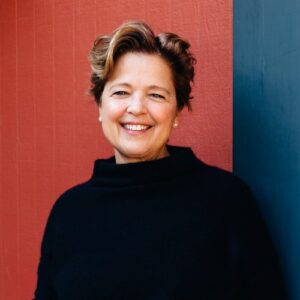
Below the Line: When I was doing research for this interview, I saw that you did the production design for Heroes, and that you received three Emmy nominations for that show, which is pretty exciting, since I liked that show quite a bit.
Ruth Ammon: That show was really one of the most important educations I ever had. I was very new to television, and I learned so much, and it was a great, very innovative show. Like we really tried out a lot of new ideas, new concepts, new visual effects, and that was really exciting, and really different for me and kind of led me on the path to these other big shows.
BTL: I know you’ve been a production designer for a while, but I’m curious how you started down that road.
Ammon: I got into it very, very early, but really by mistake actually. I had studied art and art history and was doing quite a bit of traveling for that. Basically, a movie came to town, and I started working with the production designer on that movie, and I knew that it was the perfect role for me, because it was a combination of art history, compositions understanding of culture, color, framing, and detail, but actually going out and doing it in the field, which was like the perfect combination for me. I was actually waiting tables on Budd Schulberg‘s nephew was my first job.
BTL: Did you study architecture at all?
Ammon: No architecture. In an art history course, you learn architecture, you learn architecture vernacular. An art history background, I think is a really great background for people who want to get involved in cinema and art direction and production design, because paintings are storytelling, and that storytelling is a composition, its color, its texture, it’s a mood, and it’s a story, and it’s lighting. These are all the things that a production designer starts with. You start with what is the frame? What is the lighting? What is the time of day? What is the mood? What are they wearing? What is the story happening? And how do you want to tell it? Although the actual execution of it ultimately is a director’s job and a cinematographer, I always start by setting up that kind of key frame in my mind, and designing my set my designs from there.
BTL: How did you get involved with Solos? Had you worked with David before on anything or was this the first time?
Ammon: It was the first time, and it was during COVID, and I had worked with Pixie Wespiser, who was his line producer, but they called me. I had one of the most exquisite connections that I’ve ever had with a showrunner. I mean, it was right off the bat, and we were in the early days of COVID, when we were all wondering what our futures were going to be, and we were all inside our homes. Talking to David about this show, and his voice for this show was just really a deep connection, and I knew I really wanted to do it. I guess also when he said Helen Mirren space shuttle, of course, that was enough.
BTL: I liked the fact that it’s science fiction but it’s subtle science fiction where you might have the space shuttle episode or the Anne Hathaway one but in others, it’s pretty much our world but just with a slight twist.
Ammon: David always wanted everything very, very grounded, and then unexpectedly, he would come up with something like, “Oh, yeah, there’s an implant in their arm,” and you aren’t ready for it, so all those things are very subtle and just kind of how organic the science fiction elements were. They really just came from David, not necessarily fully scripted, but also kind of organically through the development of each episode.
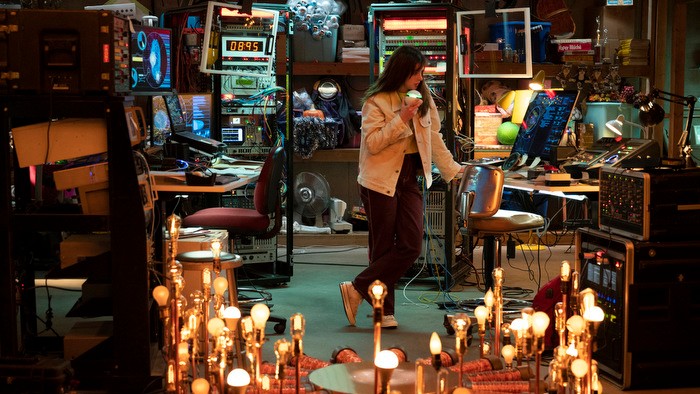
BTL: You mentioned before that this was done during a pandemic, and you obviously mostly have one or two actors on set, but what was involved on your side of things to get all the sets dressed and built. I assume a lot of this was on physical sets.
Ammon: Well, this was an extraordinary experience, because it’s one actor on the set. So first of all, you’re terrified that the audience is going to be looking at one set for 30 minutes with one actor. Trying to design something that’s versatile, and flexible in that also, logistically and emotionally, that was a huge challenge. David and William Rexer, our DP, we spent a lot of time together, and we would make this big deck for each episode, a kind of visual arc, about a character arc. So we really talked very much in preproduction about each kind of palette and emotional quality of each set.
I think for [William], and this was really one of the first productions during COVID. So we were all very, very far away from each other. It was my first time with day-long Zoom meetings, and he had a camera on the end of a 20-foot technocrane, so their connection to the actor was very, very estranged as well, and just trying to keep a space that was fluid, and that they could move around in without a lot of trouble was a huge challenge. It was really exciting for us in that we had… I’m going to call it my first virtual art department, because we were able to design almost everything in the computer. We used a lot of virtual reality programs to design all these sets. So we got to show David and Will the visual effects, and we were able to kind of create and suggest moving visual effects for each of the episodes. We actually created them as a little movie clip, and we were able to present it to David and Will and Amazon in preproduction before we shot it, so everyone could see like, “Oh, this is what happens.” And then those elements would go to our visual effects team. All of our sets are built in real detail in 3D models, so that everything that we built could be rerendered in visual effects. Even the atmosphere around Helen Mirren’s Peg, not only did we design that spaceship, we designed the exterior of it, and we were able to put it in the atmosphere for Sam Taylor-Johnson to actually see it pass by the moon and kind of time it and those elements went to visual effects, and they expanded on it, of course, but we were able to pre-vis the entire show, which was really exciting. It just gets everyone on the same page, and I think it’s very efficient.
BTL: I’m glad you brought that up, because I wanted to ask you about virtual production versus building physical sets for the actors can interact with. I’m curious about that, especially with Constance Wu’s set, which has all sorts of stuff that she’s interacting with. How did you decide on what to do physically?
Ammon: That was really fun. I mean, I had a blast on that one, because it was one of those things like, “How do you take this kind of non-emotional room and create an emotional environment?” So much about David and how he works, there’s always this inner child, and there’s always like a nostalgia for childhood. I kind of played on that quite a bit, as you can see, and just adding childhood elements and pushing towards kind of earlier, more nostalgic childhood toys then might be from his generation. He kind of liked the idea of going back a little bit further to the ’70s and ’60s. That was a part of giving Constance a wide playing field, so she could move around this seemingly kind of dull environment, and it could be lit and explored a lot rather than just staying in one place. I mean, each of these is like a play because there is almost like a proscenium that they’re in. So it was a little bit terrifying, actually. [laughs]
BTL: But it was still a mix of visual effects and physical objects for most of the segments?
Ammon: I think most of it is physical. I mean, if we’re talking about Uzo Adubo’s episode, most of it was real. I haven’t seen them, but I’m sure visual effects added to them and kind of built it out, and they probably extended it, but so much of that was real. I think it was really important to David, that the actual environment that the characters were living in was very, very real. Because they’re there for 30 minutes, and you want them to be able to interact with real things and not interact with a green blob. It’s mostly real 3-dimensional objects.
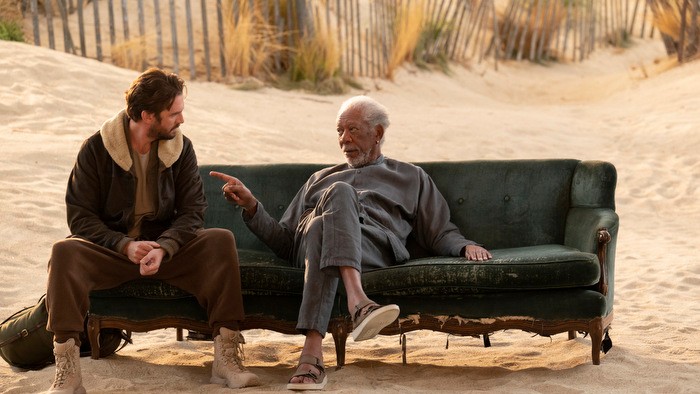
BTL: One thing I was interested in was the Stuart episode with Morgan Freeman, which looks like you just found a beach for it, but then way in the background, we see this futuristic building. Was that put there with visual effects or was that something done on set with forced perspective.
Ammon: We built that building. [laughs] That was like a 100 foot by 100-foot beach. That beach, I have to say, was inspired by my mother’s beach in New Jersey and Will Rexer had just come from Long Island, so both of us really wanted the sun rising in the East. We wanted an Eastward-looking beach, as opposed to a Western. So we were both kind of in that Northeastern kind of vibe with the beach, and the building we actually built. It didn’t even look like they extended it in the trailer that I saw, because David wanted, again… like I originally put in a more traditional building, and he wanted us to push it a little farther. So we made it kind of a retro-futuristic feeling, so it’s kind of like a brutalist building, but as in the future.
BTL: I loved it, although you only really see it at the very end of the sequence, when it shows up, and you go, “Wow, that’s interesting.”
Ammon: We built that! [laughs] It makes a difference. It’s always the argument now about what you build and what you don’t, and I’m finding more building for those kinds of things that the actors come in closer contact with, which is kind of richer for the scene. I’m on a bigger visual effects show right now, and we’re finding that the actual building of things kind of helps so much with the visual effects in the long run, so you kind of ground everything in reality first.
BTL: What was the shoot like for this show? You obviously have seven completely different sets for each actor. That’s very unusual for a show to be like this, since you usually have sets you can reuse, but here, you have seven completely separate locations. So how did you manage to be building while they were shooting other episodes?
Ammon: So what we did is we flip-flop stages. So we had two stages, and honestly, we could have used three, but so we flip flop them. So Peg had a very small footprint, so we were able to put Peg and Nera’s log cabin, directed by Tiffany Johnson, we were able to pre-build two [sets], so in the beginning, we had two sets up already. It was very rushed, because it’s also the first show that a lot of people did during COVID — it was like early in August, so everyone was very, very, very careful about who could go onto the stage when the construction was there or when scenic was there. And then they had to be out of there, so we couldn’t overlap at all. So that was definitely a scheduling challenge. But everyone was game, and everyone was so happy to be working on something. Although there were big builds, it was very focused, so you weren’t running around in vans. You had your office, and your Zoom, and then the stage, and that was it. In some ways, I would never say easy, but it was really pleasant, because you could focus on a certain amount of problems at one time, instead of like now on a big show, I’m like I’m running all over, five hours a day driving. It was just nice to be focused on seven different problems.
BTL: It turned out great. It’s like a one-person show on Broadway but it’s seven of them. I don’t usually binge watch but since they’re only 30 minutes, I could watch two or three at a time.
Ammon: That makes me so happy. Did you have a favorite?
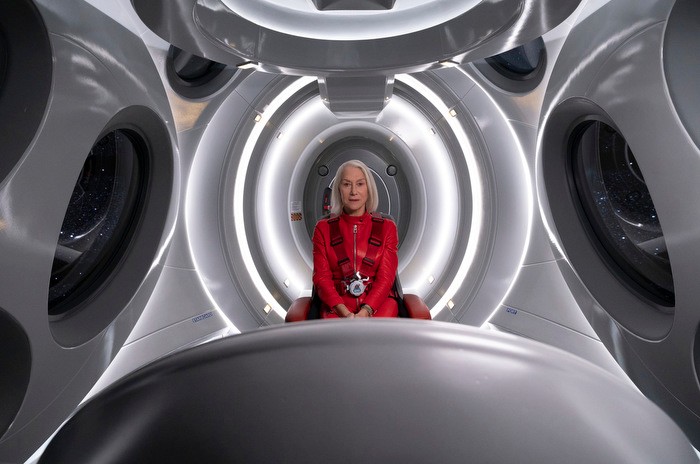
BTL: Oh, good question. I didn’t like the Constance Wu one at first, but then I really liked it by the end. The Anne Hathaway one I really liked, but that was also the first one I watched.
Ammon: I mean, for us, it was really the British baking show of television design, because honestly, this week it’s bread, this week it’s cake, this week it’s pudding. Every single set was a design challenge. It’s like if you were, having a class in production design or even scenery design, each one had such different logistics and issues and conditions that as a production designer or art director that you have to deal with, like doing terraforms, or just how do you create a beach? What does it take to create a beach? Then how about an indoor-outdoor house, or just the space shuttle. That was really the first time I’d done such an organic shape, and that for me in one way was the most exciting, because it was a challenge. I’d always been interviewed for a lot of the big spaceship movies or TV shows, but never really got those jobs, because girls don’t always get to do space shuttles. I was just so excited to not only design the space shuttle but to design a space shuttle with Helen Mirren, another woman, and directed by Sam Taylor-Johnson so it was like a triumvirate of women doing something that’s usually a male kind of, usually male… it’s a male-dominated field, and it was just really fun having three women working on this. There was also a female costume designer, but David would be the first person to kind of bring that to the forefront, because he was very, very committed to having a really diverse and open working environment.
BTL: It turned out great. I hope it does well enough that David and Amazon might want to try to do more of these, because it’s a great showcase for all these talented actors and the craftspeople behind the scenes. It was a really amazing experiment, if I can call it that, or at least something very different.
Ammon: Oh, it was an experiment.
All seven episodes of Solos are now available to watch on Amazon Prime Video. Look for our interview with Costume Designer Shiona Turini later this week.
All photos courtesy of Amazon Studios; photographer Jason LaVeris (except where noted).





